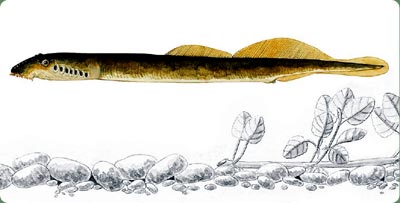Lethenteron zanandreai Po brook lamprey
92/43/EEC Directive ann. II and V Lampreys belong to the group of vertebrates called agnates, which means "without jaws". They have a cartilaginous skeleton and skin without scales, their special feature is the circular suction mouth equipped with small sharp teeth.
Almost all the lampreys are migratory fish. Young individuals live in fresh waters, while adults live in the sea. Adults of some species are parasites and feed on the blood of fish which are attached with their sucker mouth. Po brook lamprey is a species that does not migrate and spend their entire live only in freshwaters, cold and clear as those of the resurgences.
The larva is no longer than 20 cm, the adult a few inches less.
The breeding season begins in January and lasts until late spring.
To reproduce, the mature individuals gather in places of spawning, swimming tangled. This behavior is called "care" and lasts for several days. Eggs are laid on gravel. The larvae hide themselves in the muddy bottoms where they feed on detritus. They become mature after 4-5 years as a result of a metamorphosis two months long.
Unlike other lampreys, which as adults feed on the blood of marine fish, the adults of the Po brook lamprey do not feed and die few weeks after reproduction.
The Po brook lamprey is endemic of the alpine side waterways of the Po Valley and lives in the resurgences waters of the Friulian lowlands and foothills. It has been described for the first time in 1955.
It is included in the Annexes of the Habitats Directive and in the Red List of animals in Italy as an endangered species due to the destruction of riverine and resurgence habitats.
This species is present in all Italian regions except the islands, but is considered a species in decline because of alteration of habitats: channels and other interventions such as levies on beds of gravel, water pollution and groundwater lowering.
It also appears to be influenced by the massive repopulation with salmonids because trouts hunt actively the lampreys, especially the larval stage. 
Iconografia dei pesci delle acque interne d'Italia
S. Zerunian, T. De Ruosi - 2002
Ministero dell'ambiente e della tutela del territorio
Istituto Nazionale per la Fauna Selvatica "A. Ghigi" |

|